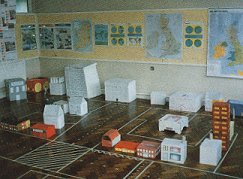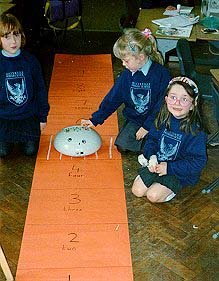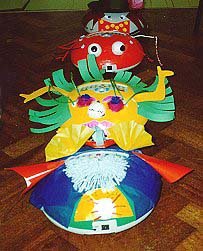
|
Feedback Form

ROAMER - A CROSS-CURRICULAR AID

During the month of January 1993, the South Eastern Education and Library Board held in-service courses for Key Stage 1 teachers coping with the common curriculum. It was felt that Roamer would be a valuable element in teaching young children many of the required geographical concepts in an exciting and effective way. Desi Donnelly explains how.
 Roamer village - notice crossing box junction.  Children using Roamer on number line.  Roamer characters for K.S.1. |
The Roamer was chosen because the Northern Ireland Geography Programmes of Study make the following stipulations:
"The study of Geography in this Key Stage should be integrated with play and linked with work in other areas of study."
"Pupils' interests, experiences and capabilities should be taken into consideration."
"Practical activities, inside and outside the classroom should be encouraged."
"Pupils should have opportunities to use simple instruments to make measures."
"The use of information technology should be encouraged."
Teachers feel inundated with a welter of requirements that impose great pressure upon them. We felt that by giving these teachers "Hands-on" experience of Roamer they could simultaneously fulfil many A.T.s in different subject areas such as geography, maths, science, art and design, technology, music and language.
Northern Ireland has its own form of the National Curriculum and whilst the headings of the Attainment Targets for geography may differ from those on the mainland, the aims and content are basically the same. As we were working at Key Stage 1 it was decided to confine our attention to the first three levels of each Attainment Target. We felt that the Roamer had relevance for the following:
| A.T.1 Methods of Geographical Enquiry | |
| 1b | Follow simple directions. |
| 1c | Describe the position of objects in relation to other objects. |
| 2b | Choose a route for a simple journey. |
| 3b | Use simple instruments to make measurements. |
| 3e | Use N.S.E & W as directions. |
| 3f | Draw simple maps not to scale. |
| 3g | Locate squares on a plan or map using letter/number coordinates. | A.T.2 Physical Environments A.T.3 Human Environments |
| 1a | Describe different kinds of jobs. |
| 1b | Describe different means of transport. |
| 2a | Identify some of the goods and services people need. |
| 2b | Explain why people travel. |
| 2c | Identify the purpose for which different buildings are used. |
| 3a | Identify some of the foods and services needed in the local area and elsewhere. |
| 3b | Recognise that there are different types of dwellings in the local area and elsewhere. | A.T.4 Place and Space |
| 1a | Describe some features they see in their local area. | A.T.5 Issues in a Changing World |
| 2 | Environmental problems - traffic - Road Safety Tufty Club - Green Cross Code etc. |
The Curriculum and Resources Centre for the S.E.E.L.B. is situated at Dundonald outside Belfast, so it was decided that we would make a mock-up of this area using cardboard boxes as buildings. We included such local buildings as Stormont Castle, Ulster Hospital, schools, fire station, supermarkets, McDonald's Drive-Thru, shops, a church, a garage and local hostelries. We also had a variety of detached, semi-detached and terraced houses. The roads were laid out with junctions, crossings and street furniture. Once the town was created it took no great leap of imagination to visualize the people who lived there, their roles and journeys around the streets.
Each teacher had seen the Valiant video on how to program a Roamer and we started with simple directional work on a Number Line from 1 to 9. Many children tend to count the number on which Roamer is sitting rather than the next number in the line. This is an opportunity for the child to physically pace out the number of steps and to program Roamer. Such concrete learning experiences are a great reinforcement to the paper number line and are intended as a extra dimension rather than a replacement for the paperwork. Teachers, at the same time, are doing numbers in maths, simple directions in geography and controlling a programmable device in technology.
We then did variations on the number line using number cards and various
forms of dice. We progressed to making journeys on the number line using
forward and back. Then we tried pacing return journeys in our town using
the commands forward, back and wait. Each journey had to be made for an
ostensible reason and this brought language, creativity and role-play
to our activities. The teacher learned how Roamer could be turned without
the necessity of using degrees ie.  [180] G0.
[180] G0.
One of the enjoyable aspects of Roamer play is cooperative work using more than one Roamer. This involves negotiation, timing and consensus. To this end the teachers undertook such activities as "follow-my-leader", "formation dancing", and "kissing Roamers". The laughter and shouts of the teachers themselves showed the value of such communal activities, which though apparently trivial have a strong mathematical undercurrent. During the course teachers got an opportunity of designing a jacket for their Roamer using such materials as cloth, cardboard, tissue paper, polystyrene, gummed paper and pipe-cleaners. This further enhanced the atmosphere.
Teachers used Roamer in a variety of mathematical ways. They were taught
how to use it as an approximate metre-stick ie  [99] G0, and as a centimetre ruler ie.
[99] G0, and as a centimetre ruler ie.  [1] G0. They saw how children can use their hand-span in various ways
to estimate distances and confirm them with Roamer. They then returned
to the town to negotiate distances, turns, crossings and junctions. They
saw how a Roamer fitted with a control box could act as a traffic light
for others, how a Roamer could be fitted with LED indicators and how a
good Roamer would do its Green Cross Code at a junction, looking right,
left and right again and possibly sounding its horn before crossing a
road.
[1] G0. They saw how children can use their hand-span in various ways
to estimate distances and confirm them with Roamer. They then returned
to the town to negotiate distances, turns, crossings and junctions. They
saw how a Roamer fitted with a control box could act as a traffic light
for others, how a Roamer could be fitted with LED indicators and how a
good Roamer would do its Green Cross Code at a junction, looking right,
left and right again and possibly sounding its horn before crossing a
road.
A simple co-ordinate grid had been laid out on the floor and teachers saw how pupils could be taught to read a simple grid correctly. ie. A3 rather than 3A, and how the four cardinal compass points could be used instead of forward, back, right or left. We concluded with a demonstration of simple shapes drawn by Roamer.
Although designed for Key State 1 many of these activities can be further developed at Key Stage 2 and our cardboard town could be used as the basis for plans and maps in higher classes.
By the end of January 500 teachers had met Roamer and gone home enthused
and far more confident in their ability to deliver the curriculum.
| Back |
|---|